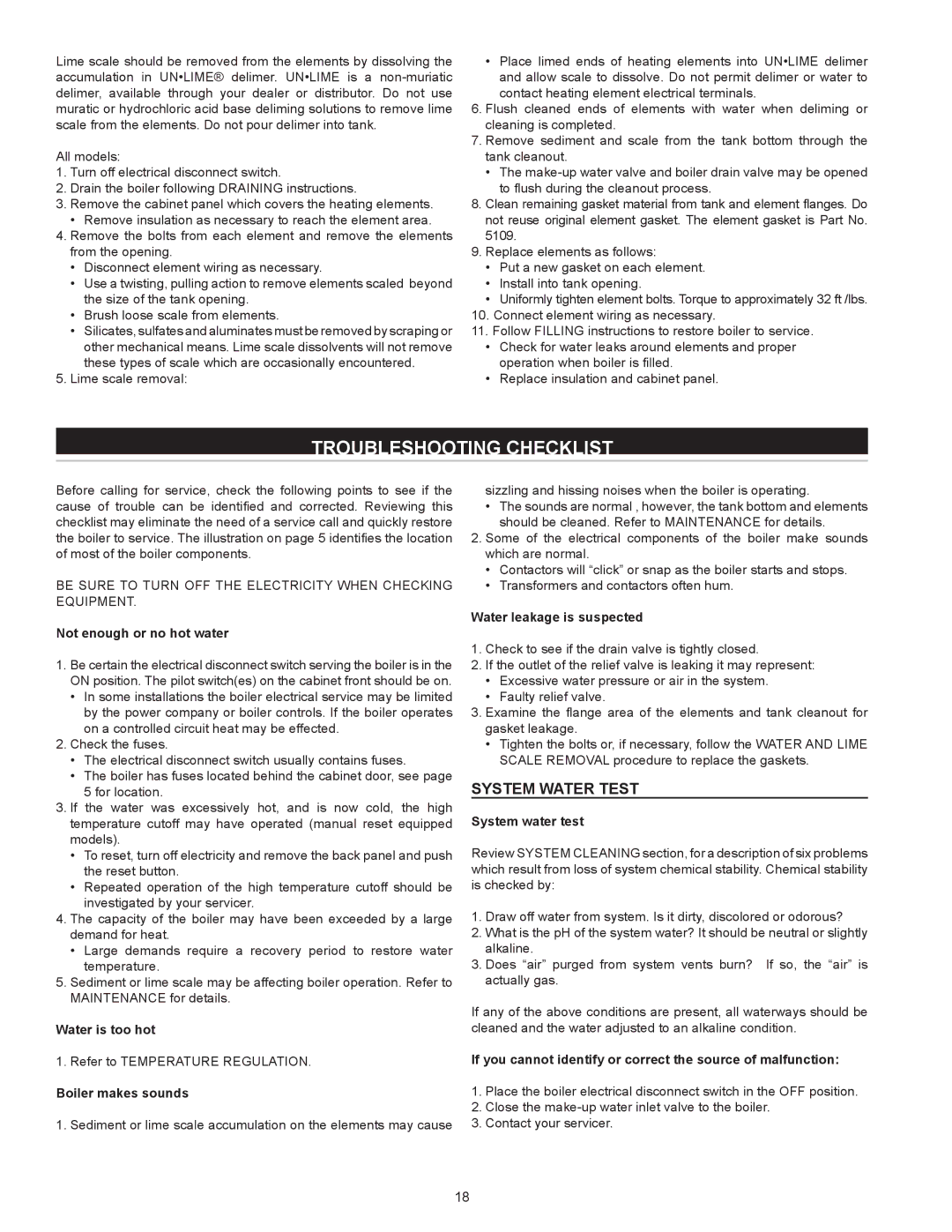
Lime scale should be removed from the elements by dissolving the accumulation in UN•LIME® delimer. UN•LIME is a
All models:
1.Turn off electrical disconnect switch.
2.Drain the boiler following DRAINING instructions.
3.Remove the cabinet panel which covers the heating elements.
•Remove insulation as necessary to reach the element area.
4.Remove the bolts from each element and remove the elements from the opening.
•Disconnect element wiring as necessary.
•Use a twisting, pulling action to remove elements scaled beyond the size of the tank opening.
•Brush loose scale from elements.
•Silicates, sulfates and aluminates must be removed by scraping or other mechanical means. Lime scale dissolvents will not remove these types of scale which are occasionally encountered.
5.Lime scale removal:
•Place limed ends of heating elements into UN•LIME delimer and allow scale to dissolve. Do not permit delimer or water to contact heating element electrical terminals.
6.Flush cleaned ends of elements with water when deliming or cleaning is completed.
7.Remove sediment and scale from the tank bottom through the tank cleanout.
•The
8.Clean remaining gasket material from tank and element flanges. Do not reuse original element gasket. The element gasket is Part No. 5109.
9.Replace elements as follows:
•Put a new gasket on each element.
•Install into tank opening.
•Uniformly tighten element bolts. Torque to approximately 32 ft /lbs.
10.Connect element wiring as necessary.
11.Follow FILLING instructions to restore boiler to service.
•Check for water leaks around elements and proper operation when boiler is filled.
•Replace insulation and cabinet panel.
TROUBLESHOOTING CHECKLIST
Before calling for service, check the following points to see if the cause of trouble can be identified and corrected. Reviewing this checklist may eliminate the need of a service call and quickly restore the boiler to service. The illustration on page 5 identifies the location of most of the boiler components.
BE SURE TO TURN OFF THE ELECTRICITY WHEN CHECKING EQUIPMENT.
Not enough or no hot water
1.Be certain the electrical disconnect switch serving the boiler is in the
ON position. The pilot switch(es) on the cabinet front should be on.
•In some installations the boiler electrical service may be limited by the power company or boiler controls. If the boiler operates on a controlled circuit heat may be effected.
2.Check the fuses.
•The electrical disconnect switch usually contains fuses.
•The boiler has fuses located behind the cabinet door, see page
5 for location.
3.If the water was excessively hot, and is now cold, the high temperature cutoff may have operated (manual reset equipped models).
•To reset, turn off electricity and remove the back panel and push the reset button.
•Repeated operation of the high temperature cutoff should be investigated by your servicer.
4.The capacity of the boiler may have been exceeded by a large demand for heat.
•Large demands require a recovery period to restore water temperature.
5.Sediment or lime scale may be affecting boiler operation. Refer to MAINTENANCE for details.
Water is too hot
1. Refer to TEMPERATURE REGULATION.
Boiler makes sounds
1. Sediment or lime scale accumulation on the elements may cause
sizzling and hissing noises when the boiler is operating.
•The sounds are normal , however, the tank bottom and elements should be cleaned. Refer to MAINTENANCE for details.
2.Some of the electrical components of the boiler make sounds which are normal.
•Contactors will “click” or snap as the boiler starts and stops.
•Transformers and contactors often hum.
Water leakage is suspected
1.Check to see if the drain valve is tightly closed.
2.If the outlet of the relief valve is leaking it may represent:
•Excessive water pressure or air in the system.
•Faulty relief valve.
3.Examine the flange area of the elements and tank cleanout for gasket leakage.
•Tighten the bolts or, if necessary, follow the WATER AND LIME
SCALE REMOVAL procedure to replace the gaskets.
SYSTEM WATER TEST
System water test
Review SYSTEM CLEANING section, for a description of six problems which result from loss of system chemical stability. Chemical stability is checked by:
1.Draw off water from system. Is it dirty, discolored or odorous?
2.What is the pH of the system water? It should be neutral or slightly alkaline.
3.Does “air” purged from system vents burn? If so, the “air” is actually gas.
If any of the above conditions are present, all waterways should be cleaned and the water adjusted to an alkaline condition.
If you cannot identify or correct the source of malfunction:
1.Place the boiler electrical disconnect switch in the OFF position.
2.Close the
3.Contact your servicer.
18
